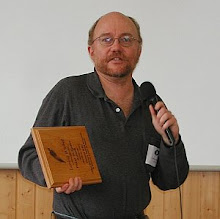For the first 15 or 20 years following establishment of the NRO in 1960, the agency had an even more benign reputation among arms-control liberals than did the NSA, and for a very concrete reason. The early imaging satellites launched by NRO disproved Soviet bomber gaps and missile gaps, thereby making the case for smaller strategic nuclear budgets (admittedly, they did not seem very small in the height of the Cold War, but could have been even larger). This tendency to rely on "national technical means of verification" led to a knee-jerk assumption by many liberals that the NRO was benign-by-design. How could a spy-satellite agency be a subject of Constitutional debate?
Those that ask this question do not realize how profoundly the NRO changed during the 1980s, and particularly in the aftermath of the Cold War. The NSA was on a mission during the Reagan years to limit the exposure of ground-based listening posts in sensitive locations like Iran and Turkey. The NRO could claim new frontiers in chip integration and RF antenna design that would allow the fielding of massive geosynchronous satellites with unfurlable antennas as large as two football fields, and "close-listen" satellites in low-Earth and Molniya orbits that would allow particular conversations (voice or email) to be picked up in specific regions of the planet. During the 1980s and 1990s, a vast array of NSA capabilities moved to space, courtesy of the NRO.
In my earlier post on NSA, I pointed out that this move made it easy for NSA to expand to full broadband intercept of all communications. It is much harder to make a satellite turn itself off for one specific region, than for the same satellite to pick up everything globally, but make much of its intercepted content deniable except when other agencies of government specifically needed that information. Thanks to NRO, the NSA was scooping up everything from the Clinton era on - not just from the post-9/11 era. Bush's FISA Bypass flap was about making collected NSA information usable and only partially deniable - prior to 2002, the information was collected but was denied to exist. The constellation of NRO satellites also made it easier for signals intelligence to update itself for the TCP/IP packet-switching era of the Internet. Many ground-based NSA resources of the past were designed for circuit-switched, nailed-up connections between sender and receiver. NRO satellites could function just as well in the packet-switched anything-to-anything world, as in the circuit-switched telco world of the past.
 During the 1980s, huge new ground stations were built at locations such as Menwith Hill in England and Buckley Field in Colorado, specifically to download, analyze, and store this massive treasure-trove of data. The rationale for these satellite-downlink stations is similar to that for the NSA's new Utah Data Center opening this summer in Bluffdale, Utah -- the stations wouldn't be built if the agencies didn't have the data to fill them up.
During the 1980s, huge new ground stations were built at locations such as Menwith Hill in England and Buckley Field in Colorado, specifically to download, analyze, and store this massive treasure-trove of data. The rationale for these satellite-downlink stations is similar to that for the NSA's new Utah Data Center opening this summer in Bluffdale, Utah -- the stations wouldn't be built if the agencies didn't have the data to fill them up.In the 1990s, organizations like Global Network Against Weapons and Nuclear Power in Space, submitted testimony to Congress on the potential problems of new classes of spy satellites. We were privately told by Air Force officials that the protests were appreciated, because no member of Congress ever raised these issues. Most members wouldn't know the difference between imaging and signals satellites in the first place, and virtually all members of Congress did not want to learn more about the NRO or NSA - rubber-stamping any new project was preferred. This led to huge scandals in the mid-1990s -- at one point, NRO Director Jeff Harris was removed from the agency because he could not account for $2.5 billion of the agency's annual budget.
The NRO influence and budget continued to grow following Sept. 11, and continues to grow today. Its classified budget is believed to exceed $15 billion. The NRO launched six satellites in the course of 2012, of which citizens were allowed to learn virtually nothing, and the agency expanded staff at its Chantilly, VA headquarters and at Buckley AFB in Aurora, CO. What happens if a contractor is upset about satellite capabilities and decides to reveal information a la Edward Snowden? Do American citizens need to know each orbital plane and each frequency band of all of NRO's spy satellites? Perhaps not. But does the public deserve to know about the general class of advanced spy satellites like Advanced Orion and Advanced Jumpseat, and their possible role in violating civil liberties? Of course they do. But the attitude of the Obama administration, and 90 percent of the members of Congress, is that the public has no right to be asking about technical intelligence agencies in the first place, let alone the right to deserve honest answers.











